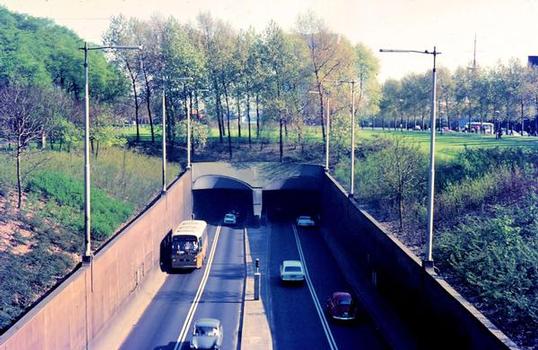General Information
Project Type
| Structure: |
Immersed tube tunnel |
|---|---|
| Function / usage: |
Road tunnel Subway (pedestrian tunnel) |
| Construction method: |
Immersed tube method |
Location
| Location: |
Rotterdam, South Holland, Netherlands |
|---|---|
| Underneath of: |
|
| Coordinates: | 51° 54' 21" N 4° 28' 1" E |
| Coordinates: | 51° 53' 43" N 4° 28' 11" E |
Technical Information
Dimensions
| total length | 1 070 m | |
| tunnel length | 550 m |
Excerpt from Wikipedia
The Maastunnel is a tunnel in Rotterdam, the Netherlands, connecting the banks of the Nieuwe Maas. About 75,000 motor vehicles and a large number of cyclists and pedestrians use the tunnel daily, making the Maastunnel an important part of Rotterdam's road network. Building commenced in 1937 and finished in 1942. There was no official opening ceremony, but the Dutch held an unofficial opening ceremony in secret without Nazi participation.
Construction of the tunnel was preceded by years of animated discussions. Although there was agreement as to the need for a new permanent connection between the two banks of the Maas river, there was lack of agreement as to whether it should be a bridge or a tunnel. A tunnel proved to be more attractive financially than a bridge, largely because of the great height a bridge would have needed to avoid hindering the passage of ships from the port of Rotterdam, the largest port in Europe.
The Maastunnel was built using the sunken tube or immersed tube method. Separate parts of the Maastunnel were built elsewhere in a dry dock, and then floated into place and sunk into a trench dug in the river bottom, a technique used in many other Dutch tunnels after the Maastunnel. The Maastunnel was the world's first rectangular shaped underwater tunnel built in this way. Earlier tunnels were all of a circular design. Each of the nine parts of the tunnel has a length of over 60 metres, a height of 9 metres and a width of 25 metres. They contain two adjacent tubes for motorised traffic, and two piled tubes for mopeds, cyclists and pedestrians next to it (accessible by escalator). At one time there was a laboratory in one of the ventilation buildings to examine the air quality in the tunnel.
The Maastunnel was opened to the public on 14 February 1942 and was the first car tunnel in the Netherlands. At the end of the Second World War overhead lines were installed to allow for the passage of trolleybuses. Although two buses were ready for these experimental rides, they were never used for public transportation in Rotterdam, as the overhead lines were removed from the tunnel and used to repair the Rotterdam tramway network overhead lines which had been destroyed during the bombing. In 1944 the German invaders placed explosives in the tunnel so they could destroy it at a moment's notice. Perhaps due to the sabotage of the detonators (the overhead lines) by the Dutch resistance the explosives were not detonated.
The length of the Maastunnel is 1373 metres (including access roads). The underground part is 1070 metres long. The lowest point of the tunnel is approximately 20 meters below sealevel. Above ground, the tunnel's location can be recognized by ist characteristic ventilation buildings on both sides of the river. It can be seen from the nearby Euromast tower as well.
Text imported from Wikipedia article "Maastunnel" and modified on 23 July 2019 under the CC-BY-SA 3.0 license.
Participants
- J. P. van Bruggen (architect)
- Ad van der Steur (architect)
Relevant Web Sites
Relevant Publications
- (1940): La construction du tunnel sous la Meuse, à Rotterdam. In: La Technique des Travaux, v. 16, n. 3 (March 1940), pp. 115-138.
- (2013): Determining the fire resistance of the Maastunnel with a mobile oven. Presented at: IABSE Conference: Assessment, Upgrading and Refurbishment of Infrastructures, Rotterdam, The Netherlands, 6-8 May 2013, pp. 114-115.
- : Immersed Tube Tunnels. A Study in Achievement. Kemp's International Publications, London (United Kingdom), pp. 27-40.
- (2013): Impact of corrosion on the first immersed concrete tunnel, the Maastunnel. Presented at: IABSE Conference: Assessment, Upgrading and Refurbishment of Infrastructures, Rotterdam, The Netherlands, 6-8 May 2013, pp. 544-545.
- Le tunnel sous la Meuse à Rotterdam (1ère partie). In: Travaux, n. 85 (January 1940), pp. 1.
- About this
data sheet - Structure-ID
20010680 - Published on:
19/11/2003 - Last updated on:
28/05/2021






